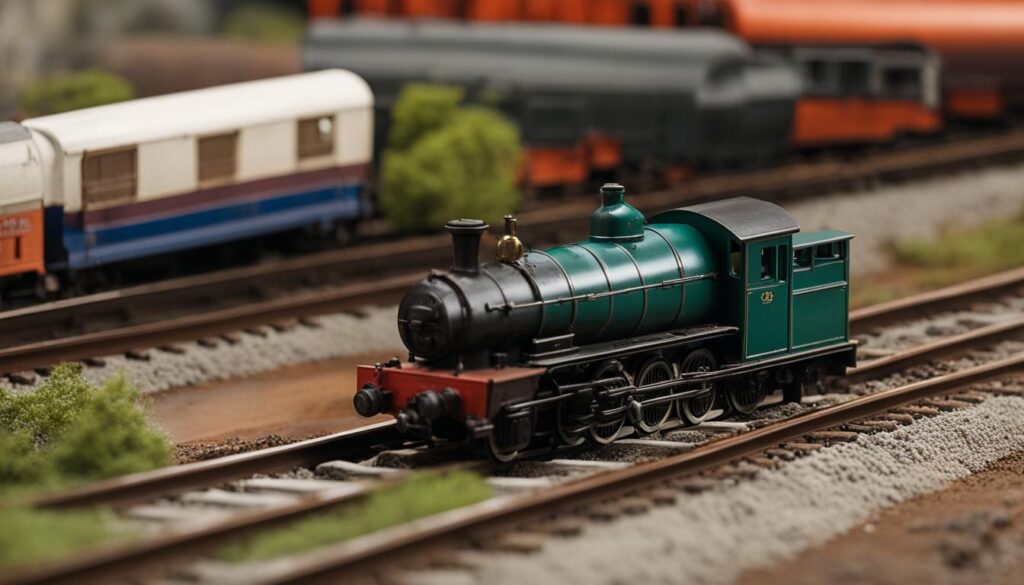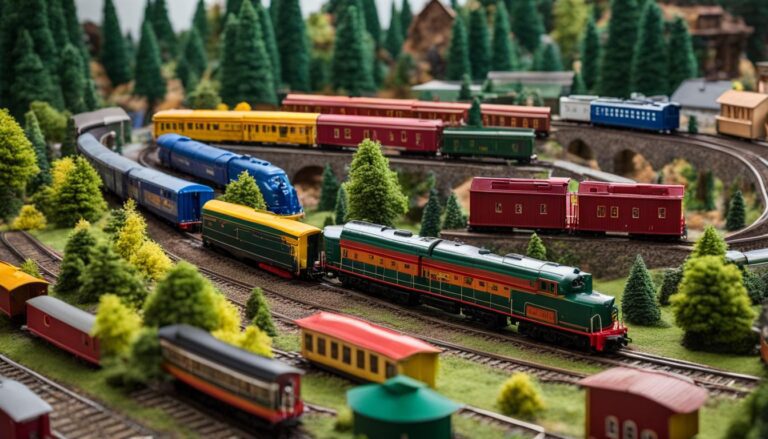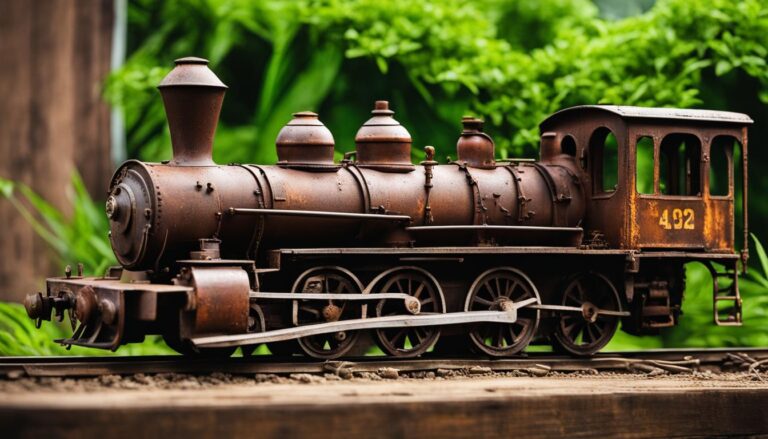How to Clean Rusty Model Train Track
Greetings, fellow model railroad fans! As passionate train fans, we know that keeping our valuable model train tracks in good shape is essential for proper operation and enjoyment of our sport as a whole. Additionally, unusual problems include rusty model train tracks that make our models look bad and make it harder for trains to move. So, feel free to relax, because this complete guide will show you a variety of effective ways to clean dirty model train tracks.
There are different ways to clean rusty train tracks, and it’s important to find the best way to do it so that your model train tracks continue to work and look good. We will look at a number of different methods, such as using Dremel, white vinegar, oils, and non-polar solvents, as well as EvapoRust. If you follow these tried-and-true steps, you can make your model train tracks look beautiful again and make sure they last a long time.
Key Takeaways:
- Model train tracks need to be cleaned regularly to stay in good shape.
- EvapoRust, Dremel, white vinegar, oils, and non-polar liquids can all be used to clean.
- To get the best results from each cleaning method, make sure you follow the directions exactly.
- For model trains to run smoothly, it’s important to stop rust and rusting from getting worse.
- Train fans can enjoy their hobby for many years if they take the time to take care of their lines.
Using EvapoRust to Clean Rusty Model Train Track
If you’re looking for a highly effective solution to clean your rusty model train track, EvapoRust is the answer. This powerful track cleaner is specifically formulated to remove rust and restore the shine to your rails. With EvapoRust, you can ensure that your model trains run smoothly and effortlessly.
Make sure your track is fully rusted before you start to clean it. This will make sure that EvapoRust can get into the rust and break it down. Before you use EvapoRust, you should wash the track with a combination of baking soda and water or vinegar if there is any loose dirt or debris on it.
To use EvapoRust, simply soak your track in the solution for a few minutes, following the instructions on the bottle. You can use a container, such as a plastic tub, to hold the solution and submerge the track. After the rust has been dissolved, thoroughly rinse the track with clean water and drain the container.
| Pros | Cons |
|---|---|
| Effectively removes rust | May require multiple applications for severe rust |
| Easy to use | Can be expensive for larger track layouts |
| Safe and non-toxic | May leave a slight residue if not rinsed properly |
“EvapoRust is a game-changer for model train enthusiasts. It has made the cleaning process so much easier and more effective. My tracks have never looked better!”
Using Dremel to Clean Rusty Model Train Track
If you’re looking for an effective tool to clean rusty model train track, the Dremel should be at the top of your list. With its powerful rotary action, it can tackle even the toughest rust and dirt buildup. However, it’s important to take precautions to avoid damaging the track during the cleaning process.
A carbon steel brush adapter for your Dremel tool will help get the rust off the rails. This brush gets rid of rust well and won’t hurt the track. To get a good cleaning, take your time and use light pressure. If you find rust spots that won’t go away, you can try hobby store-bought chemicals that are made to break down rust and dirt.
Alternatively, use a wire brush with your Dremel, acknowledging the potential for added time and effort in achieving a thorough track cleansing. Utilize a wire brush attachment tailored to the track rail’s size, meticulously clearing both the top and sides for peak performance.
“The Dremel tool is a game-changer when it comes to cleaning rusty model train track. Its versatility and power make it an invaluable tool for any model railway enthusiast.” – ModelTrainEnthusiast25


Cleaning Tips
- Don’t use your Dremel until you’ve cleaned the track of any loose metal or dirt.
- To keep yourself safe while you clean, always wear safety glasses and gloves.
- Keep your Dremel’s speed low to keep the track from getting too hot, which can damage it.
- Clean the brush adapter often to get rid of any rust or dirt that has built up.
- Clean the track, and then wipe it down with a clean, dry cloth to get rid of any leftover dirt.
By following these cleaning tips and using the Dremel tool correctly, you can effectively remove rust and ensure smooth operation of your model train track. Take your time and enjoy the process of restoring your track to its former glory.
Using White Vinegar to Clean Rusty Model Train Track
White vinegar is a versatile and affordable solution for removing rust from model train track. Its acidic properties make it an effective rust remover and cleaner. To clean rusty model train track with white vinegar, follow these steps:
- Prepare a white vinegar bath by mixing equal parts white vinegar and water in a container.
- Submerge the rusty track in the vinegar bath and let it soak for at least 30 minutes.
- Gently scrub the track with a soft brush or cloth to remove the loosened rust.
- Rinse the track thoroughly with clean water to remove any vinegar residue.
- Dry the track completely to prevent further rusting.
White vinegar not only removes rust but can also dissolve any plating that may be present on the track. A scourer made of stainless steel can be used to remove plating. In severe cases of rust, a rust remover spray can be applied to individual rust spots for targeted treatment. By using white vinegar, you can effectively clean and restore your model train track to its former glory.
Maintenance Tips:
“Regular cleaning and maintenance can help prevent further rust and corrosion, ensuring a smooth operation of model trains.”
– Train Enthusiast
Maintaining your model train track is key to its longevity and performance. Here are some additional maintenance tips:
- Regularly inspect your track for signs of rust and clean it promptly to prevent further damage.
- Keep your track dry and avoid exposing it to excessive moisture, which can accelerate rusting.
- Apply a thin coat of lubricating oil, like WD-40 or Liquid Wrench, to the track to slow down the rusting process and ensure smooth operation of rolling stock.
- Consider using a cleaning car or automated track cleaner to simplify the cleaning process and maintain the condition of your track.
Using Oils to Clean Rusty Model Train Track
When it comes to maintaining and cleaning rusty model train tracks, using oils can be a highly effective method. Not only do oils help prevent rust from forming, but they also provide lubrication for smooth operation of the rolling stock. Oils such as WD-40 and Liquid Wrench are commonly used in the model train community for this purpose.
When using oils to clean dirty model train tracks, first put the oil right on top of the rust. Let the oil soak into the rust for a few minutes so that it can loosen it up. To clean the rusted areas, use a soft-bristled brush or a piece of cloth. There will be less rust to remove because the oil will help break it down.
After the rust is gone, the track should be cleaned well with a wet cloth to get rid of any leftover dirt. This will make sure that there are no more oil or rust bits on the track. It’s best to put a small layer of oil on the track after cleaning it to stop rust from forming again.
Benefits of Using Oils:
- Prevent Rust: Oils create a protective barrier on the track, preventing moisture from coming into contact with the metal and causing rust.
- Lubricate: Oils provide lubrication for the railings, reducing friction and allowing the rolling stock to move smoothly.
- Preserve Rolling Stock: Regular use of oils can help extend the lifespan of your rolling stock by keeping the track in optimal condition.
- Ease of Use: Applying oils to clean rusty model train tracks is a simple and straightforward process that can be done by any model railway enthusiast.
By incorporating oils into your regular maintenance routine, you can effectively clean and prevent rust on your model train tracks, ensuring smooth operation and preserving the longevity of your rolling stock.
Table: Comparison of Different Oils for Cleaning Rusty Model Train Tracks
| Oil | Benefits | Application |
|---|---|---|
| WD-40 | Prevents rust, lubricates, cleans surface rust | Apply directly to rusted areas, wipe clean |
| Liquid Wrench | Prevents rust, lubricates, cleans railings | Apply directly to rusted areas, wipe clean |
Using Non-Polar Solvents to Clean Rusty Model Train Track
When it comes to cleaning rusty model train track, using non-polar solvents is a highly effective method. These solvents are not only safe to use but also leave no harmful residue behind. Unlike water-based solvents, which can lead to the buildup of metal oxides, non-polar solvents such as isopropyl alcohol provide a thorough cleaning without causing any damage. To ensure the longevity of your model train track, here are some cleaning tips:
1. Choose the Right Solvent
When selecting a non-polar solvent, opt for isopropyl alcohol with a high purity level. This will guarantee optimal cleaning results without leaving any residue behind. Avoid using water-based solvents, as they can have adverse effects on the track’s condition.
2. Gather the Necessary Tools
Get the tools you’ll need, like a soft cloth, cotton swabs, and a small brush, ready before you start cleaning. These tools will make it easier to clean places that are hard to get to.
3. Apply the Solvent
The non-polar fluid should be used to wet a soft cloth or cotton swab in order to clean the rusty model train track. Rub the cloth or brush slowly along the track, paying special attention to rusty spots. Use a small brush if you need to get into tight spots and corners. Do this again and again until the rust is gone.
4. Wipe and Dry the Track
After the rust is gone, wipe off any liquid that is still there with a clean cloth or cotton swab. To keep the track from getting new rust, make sure to dry it completely. This step is very important for keeping the track in good shape and making sure it lasts a long time.
| Advantages of Using Non-Polar Solvents: | Disadvantages of Using Water-Based Solvents: |
|---|---|
| Safe and non-toxic | Can lead to residue buildup |
| Effective at removing rust | Potential damage to track |
| No harmful effects on rolling stock | May require multiple cleaning cycles |
Additionally, by following these cleaning tips and using non-polar solvents, you can effectively remove rust from your model train track and ensure its longevity. Furthermore, remember to choose the right solvent, gather the necessary tools, apply the solvent gently, and thoroughly wipe and dry the track. In conclusion, with regular maintenance, your model train track will continue to provide smooth operation and enjoyment for years to come.


Conclusion
Additionally, cleaning rusty model train track is an essential step in maintaining the condition of your tracks. Moreover, by following effective methods such as EvapoRust, Dremel, white vinegar, oils, and non-polar solvents, you can restore the grandeur of your model train tracks and ensure smooth operation of your model trains.
Regular cleaning and maintenance are key to preventing further rust and corrosion. By taking the time to care for your tracks, you can continue to enjoy your model railroading hobby for years to come.
Remember to always follow the instructions for each cleaning method to achieve optimal results. Whether you’re using specialized solutions like EvapoRust, the precision of a Dremel tool, the affordability of white vinegar, the protective properties of oils, or the effectiveness of non-polar solvents, each method offers unique benefits for restoring and maintaining rusty train tracks.
So, don’t let rust derail your model train adventure. Take the necessary steps to restore and maintain your rusty train tracks, ensuring that they stay in top shape for continued enjoyment.
FAQ
How do I clean rusty model train track?
EvapoRust, Dremel, white vinegar, oils, and non-polar chemicals are just a few of the effective ways to clean rusty model train track. Each method works in its own way and has its own perks. For the best results, it’s important to follow the directions for each way of cleaning.
What is EvapoRust and how does it work?
One well-known way to soak the track and get rid of rust is with EvapoRust. It works very well to clean dirty model train track. If you want to use EvapoRust, soak the track in the fluid for a few minutes as shown on the bottle. Once the rusty track is clean, make sure to wash it well with clean water and empty the tank. EvapoRust is a great way to make your model train tracks look like new again.
Can I use a Dremel to clean rusty model train track?
Of course, a Dremel can be used to clean up old model train track. To get the rust off the rails, you need to use a carbon steel brush with the Dremel. You can also use special chemicals to clean the track and get rid of rust and dirt without hurting it. You can also use a wire brush, but it might take longer and more work to clean the track completely.
How can white vinegar help in cleaning rusty model train track?
If you want to get rid of rust on model train track, white vinegar is a great and cheap option. Plates that are on the track can also be taken off with this machine. A stainless steel scourer can be used to get rid of plating on the track. A rust eraser spray can be used to treat individual rust spots when the rust is very bad. It’s important to dry the track well after washing it to stop it from rusting again. A cleaning car can also be a handy way to automate the cleaning process.
What role do oils play in cleaning rusty model train track?
Model train track that is rusty can be cleaned with oils like WD-40 and Liquid Wrench. Liquid Wrench can be used to clean the rails and WD-40 can be used to clean the surface of rust. These oils can keep the track from rusting and make it look brand new again. They can also be used to keep the fences from rusting and to grease them.
Are there any other solvents I can use to clean rusty model train track?
Yes, chemicals that aren’t polar can clean rusty and dirty model train track. The solvents in this list are safe and won’t leave behind any dangerous chemicals. Solvents that are based on water should not be used because they can leave behind leftovers and make metal oxides build up on the track. It is safer to clean rusty model train track with non-polar chemicals like isopropyl alcohol. They work to cut down on how often the track needs to be cleaned and can help keep it in good shape.
Why is it important to regularly clean and maintain model train track?
Cleaning and maintaining model trains on a regular basis is important to stop rust and rusting from getting worse and to make sure they run smoothly. Modelling fans can keep enjoying their hobby for many years to come if they take the time to take care of their tracks.







